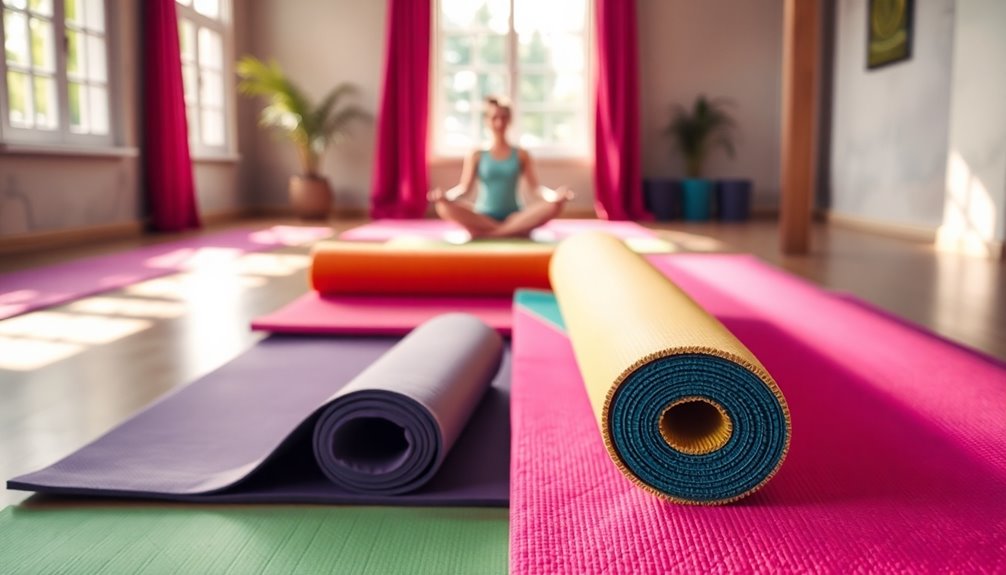To choose the right yoga mat, start by considering your yoga style. Dynamic practices like Vinyasa need mats with good grip, while restorative sessions benefit from thicker mats for joint support. Next, look at materials; eco-friendly options like natural rubber are great choices. Thickness matters too—aim for 5mm to 8mm for comfort or 2mm to 4mm for stability. Don't forget traction; a non-slip surface helps you stay secure during poses. To conclude, think about portability and budget. With these tips in mind, you'll be closer to finding your perfect mat, and there's plenty more to discover about maximizing your practice.
Key Takeaways
- Identify your yoga style to select a mat with the appropriate grip, cushioning, and stability for your practice.
- Choose eco-friendly materials like natural rubber or jute for sustainability and a better tactile experience.
- Consider mat thickness: opt for thicker mats (5mm to 8mm) for joint support or thinner mats (2mm to 4mm) for enhanced stability.
- Look for mats with excellent traction and moisture-wicking properties to prevent slipping during dynamic or sweaty practices.
- Ensure the mat is lightweight and portable if you plan to practice in various locations.
Consider Your Yoga Style
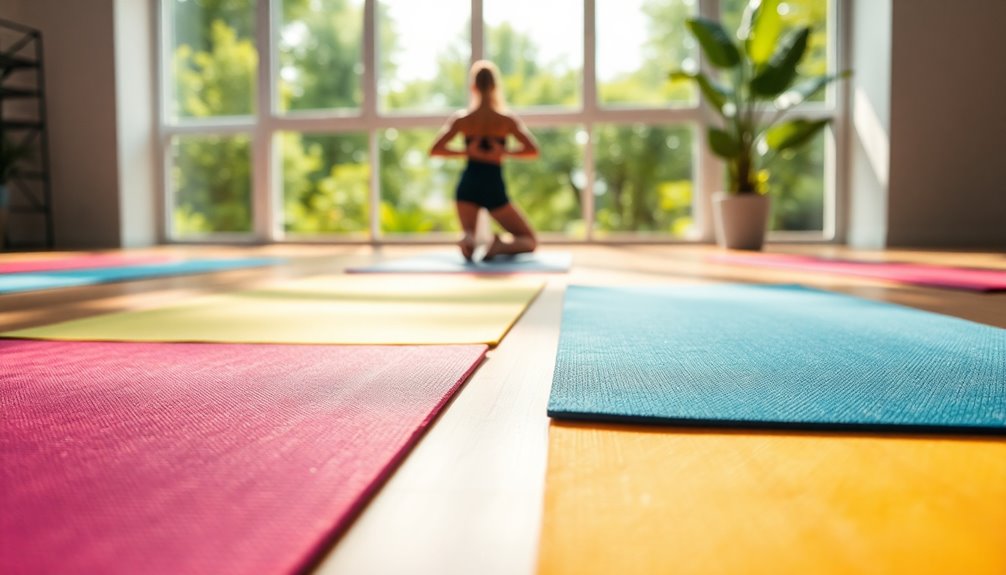
When selecting a yoga mat, it's essential to take into account your yoga style since different practices necessitate varying levels of grip, cushioning, and stability. If you're into dynamic styles like Vinyasa or Ashtanga, you'll want a mat that provides excellent grip to prevent slipping during those fast-paced flows. Look for mats with textured surfaces; they'll help you maintain alignment support as you move through challenging poses.
On the other hand, if your practice leans toward restorative or yin yoga, you may prefer a mat with more cushioning to support your joints during longer holds. A thicker mat can enhance your comfort and help you relax deeper into the poses, creating a welcoming space for your practice.
Don't forget about eco-friendly options! Many brands now offer mats made from sustainable materials like natural rubber or jute. Choosing an eco-friendly mat not only benefits your practice but also supports the planet, fostering a sense of community among environmentally-conscious yogis.
Ultimately, selecting the right yoga mat is about finding what feels best for you. Whether you need extra grip, cushioning, or an eco-friendly option, there's a mat out there that'll support your unique practice. Trust your intuition and explore different styles until you find the one that resonates with you. By doing so, you'll create a personal sanctuary that encourages growth, connection, and belonging on your yoga journey.
Evaluate Material Options
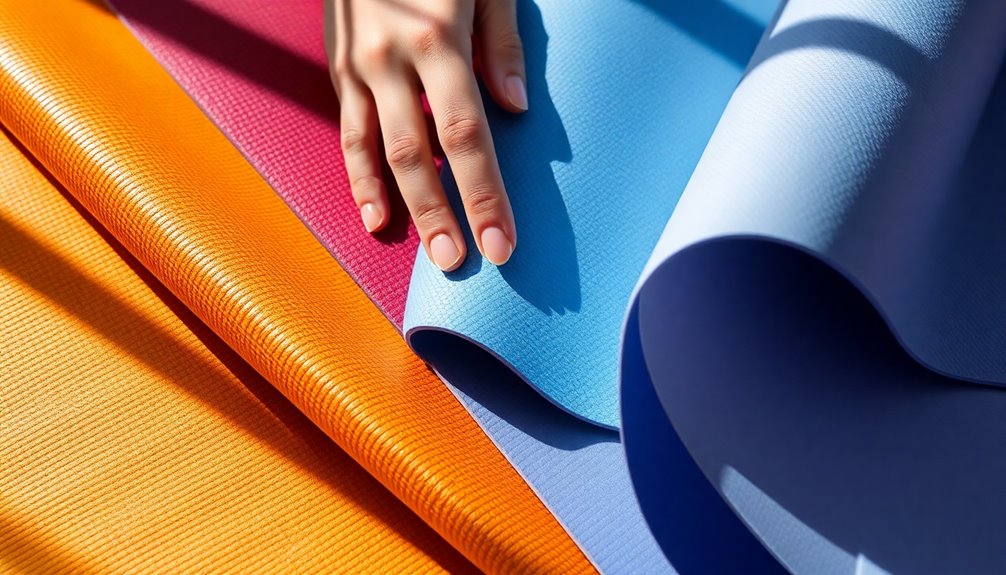
Your choice of material can significantly impact your yoga experience, so it's vital to assess the options available. When choosing a yoga mat, you'll want to ponder the balance between durability and eco-friendliness.
Many mats are crafted from PVC, which is highly resilient and resistant to wear, making it a popular choice for intense practices. However, if you're inclined towards an eco-conscious option, contemplate mats made from natural rubber, jute, or TPE. These materials are biodegradable and often offer a distinctive tactile experience, but they may not endure as long as synthetic alternatives.
Texture preference is another critical factor. Some yogis prefer a smooth surface for a gentle flow, while others seek a textured grip to prevent sliding during challenging poses. If you perspire a lot, a mat with superior grip can improve stability and safety. Search for options with moisture-wicking properties to guarantee you remain centered and comfortable. Additionally, consider incorporating mini bands into your routine for effective muscle toning and enhanced stability during poses.
Lastly, don't forget to try out your potential mats in-store if feasible. Unroll them, feel the texture, and observe how they react to your movements. Discovering a mat that resonates with you won't only enhance your practice but also nurture a sense of belonging in your yoga journey. Remember, the right material can elevate your practice, so take your time to explore and select what feels best for you. You're not simply choosing a mat; you're investing in your well-being and connection to your practice.
Assess Thickness and Cushioning
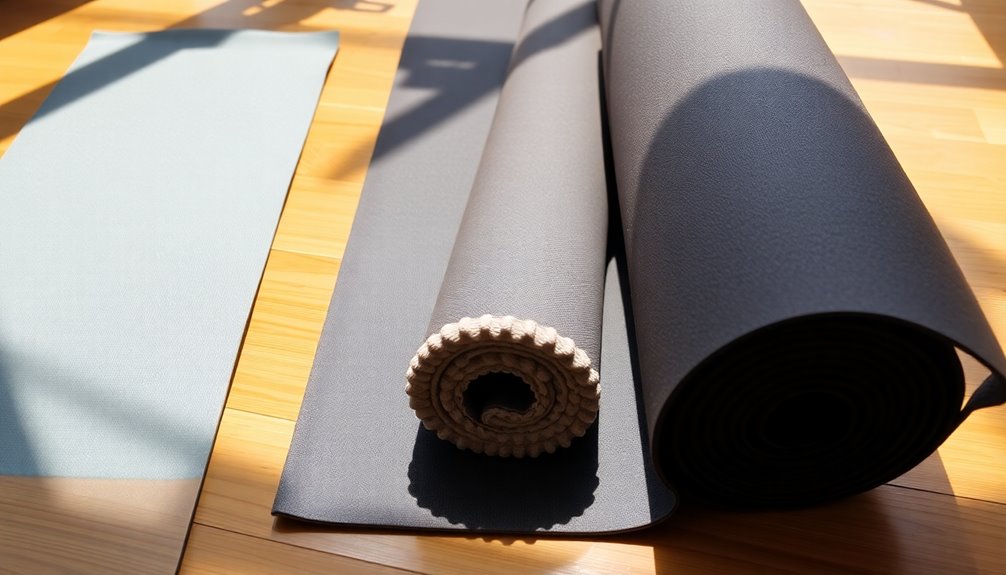
Thickness and cushioning play a pivotal role in your overall comfort and support during yoga sessions. When selecting a mat, it's important to find a thickness that aligns with your practice style and comfort level.
Thicker mats, typically around 5mm to 8mm, offer more padding, providing excellent joint protection—especially beneficial for those with sensitive knees or wrists. If you practice on hard surfaces, this added padding can make a significant difference.
On the other hand, thinner mats, about 2mm to 4mm, enhance stability and connection to the ground, which can improve your alignment support during poses. They're often favored by practitioners who value a more grounded feel during their practice. Consider how much padding you need to maintain your comfort level while also enabling you to stay connected to the earth.
Durability is another aspect to keep in mind. A mat that wears out quickly can compromise its padding and support, leading to discomfort over time. Investing in a high-quality mat ensures that you'll have reliable joint protection and consistent performance through countless yoga sessions. Additionally, just as glute strength impacts lifting capacity, the right thickness can influence your overall practice experience.
Ultimately, the right thickness and cushioning will support your unique practice and help you feel more at home on your mat. Take the time to explore different options and trust your instincts—your body will thank you for finding the perfect balance of comfort and support.
Check for Traction and Grip
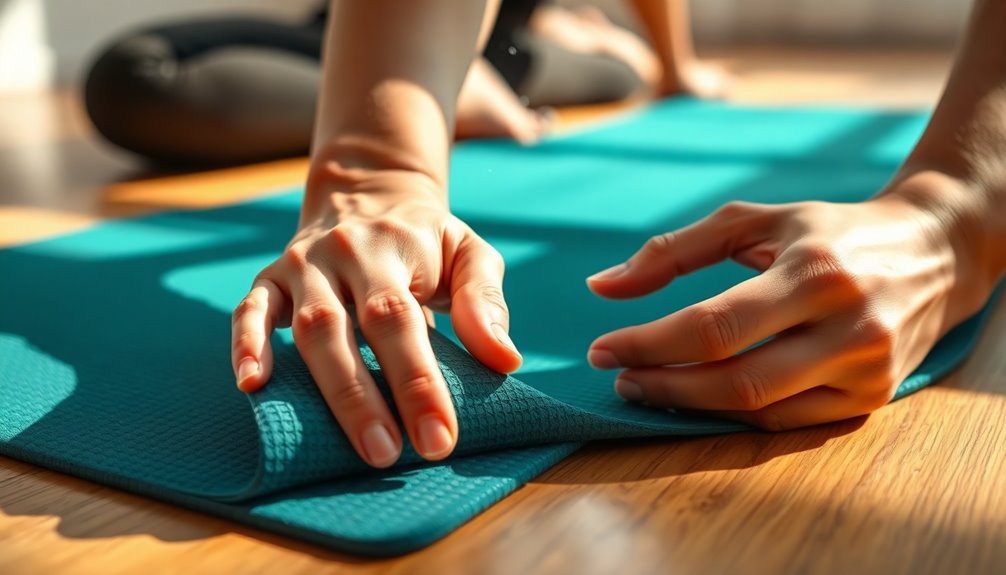
Finding a yoga mat with excellent traction and grip is pivotal for a safe and effective practice. You want to feel confident as you flow through your poses, and a non-slip surface can make all the difference. When you're in downward dog or attempting a challenging balance pose, the last thing you need is to worry about slipping. Look for mats specifically designed to provide strong traction, even when you're sweaty.
Consider the material of the mat—natural rubber often offers superior grip compared to synthetic options. Additionally, texture plays a significant role; a slightly textured surface can enhance your grip, allowing you to focus on your practice rather than your footing.
Sweat absorption is another important factor. During a hot yoga session, your mat should be able to handle moisture without becoming slippery. Mats made from moisture-wicking materials can absorb sweat effectively, helping to maintain traction throughout your practice. Make sure to read reviews or test different mats to find one that meets your needs. A strong core can also improve your balance and stability during yoga, enhancing your overall practice with comprehensive strengthening.
Think About Portability
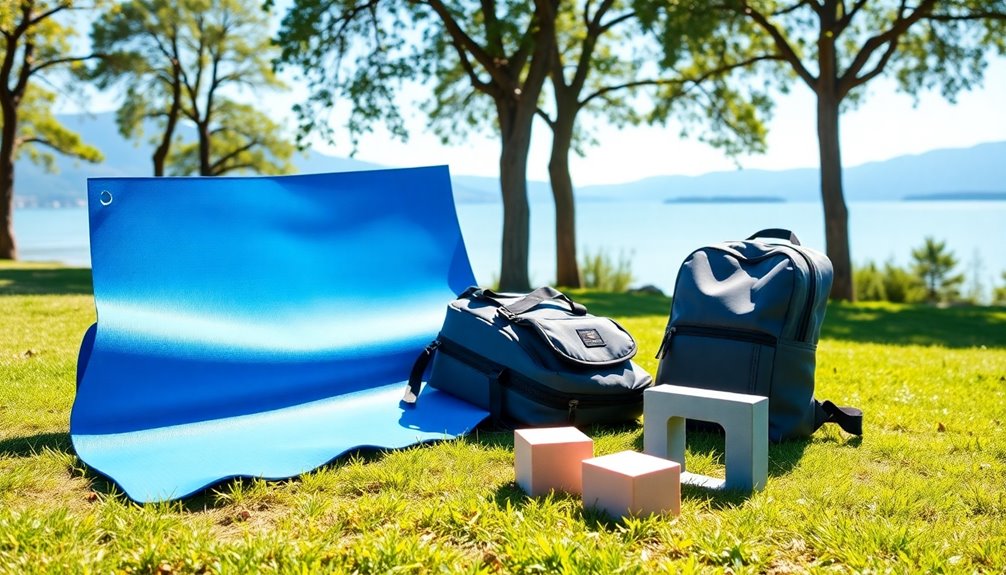
When selecting a yoga mat, portability can be just as vital as traction. If you're someone who enjoys practicing in different locations—whether it's at home, in a studio, or outdoors—considering how easy it is to carry your mat is important. A travel-friendly mat not only enhances your yoga experience but also guarantees you can practice whenever inspiration strikes.
When examining a mat's portability, pay attention to its weight and thickness. Heavier mats might offer better stability but can be cumbersome to transport. Conversely, lightweight mats are easier to carry but might have weight restrictions for durability. Here's a quick comparison to help you decide:
| Mat Type | Portability Features |
|---|---|
| Lightweight Mat | Easy to carry, perfect for travel |
| Standard Mat | Balanced weight, versatile usage |
| Heavy-Duty Mat | More stability, less portable |
Incorporating a portable mat into your routine can also help you maintain essential amino acids needed for energy and overall wellness.
Set Your Budget
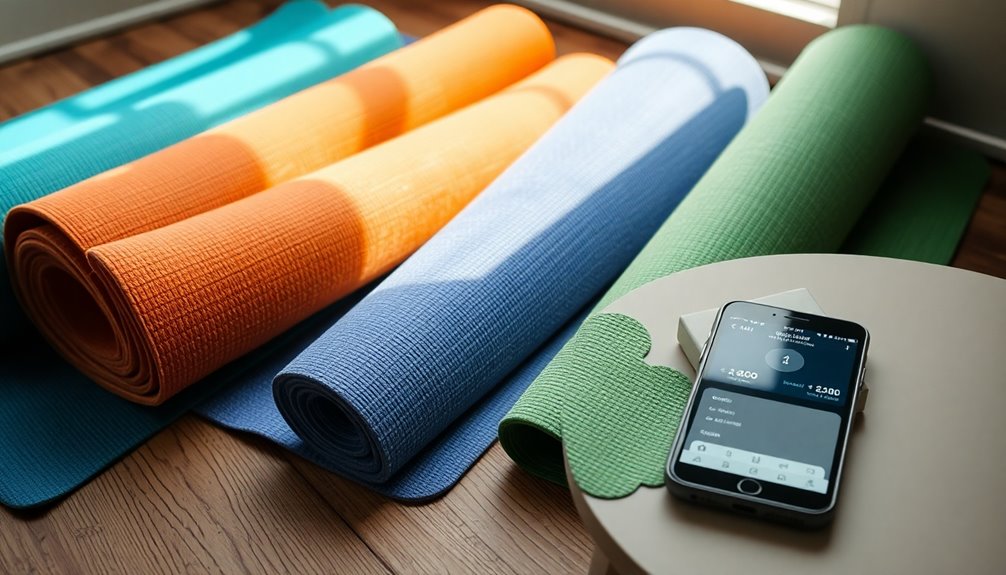
Setting a budget for your yoga mat is essential to ensure you find the right balance between quality and affordability. Before delving into the myriad of options available, it's crucial to establish what you're willing to spend. This helps you narrow down choices and prevents you from feeling overwhelmed by the vast selection.
When considering your budget, keep in mind that quality often correlates with price. While it's tempting to go for the cheapest option, investing a bit more can lead to a mat that lasts longer and performs better. Think about the features that matter most to you—like thickness, material, and grip. These factors can influence both the cost and your overall experience during practice.
Don't forget to conduct a brand comparison. Some brands are known for their high-quality mats, while others might offer lower-priced options that sacrifice durability. Take time to read reviews and ask fellow yogis about their favorite brands. You might discover some hidden gems that fit your budget and align with your needs.
Lastly, be open to exploring sales or discounts, especially during seasonal promotions. This way, you can snag a quality mat without breaking the bank. Setting a thoughtful budget not only helps you find a mat that feels good but also fosters a sense of belonging in your yoga community, where everyone appreciates the value of both quality and mindfulness in their practice.
Frequently Asked Questions
Can I Use a Yoga Mat for Other Exercises?
Absolutely, you can use a yoga mat for other exercises! Whether you're into Pilates, bodyweight workouts, or even some light stretching, a yoga mat serves as a great foundation. Just consider the durability of your mat, especially if you'll be using it for high-intensity cross training options.
A quality mat can handle various activities, helping you feel grounded and connected during your workouts. So, feel free to explore and enjoy your fitness journey!
How Often Should I Replace My Yoga Mat?
So, you think your yoga mat's invincible? Well, it's not! On average, you should replace it every 6 to 12 months, depending on its durability and your maintenance schedule. If it's looking worn or losing grip, it's time for a new one.
Keep in mind the material considerations and your budget constraints. Investing in a quality mat not only enhances your practice but also shows you care about your well-being and community!
Are There Eco-Friendly Yoga Mat Options Available?
Yes, there are plenty of eco-friendly yoga mat options available!
You can find mats made from sustainable materials like natural rubber or jute, which are great alternatives to traditional PVC.
Look for biodegradable options that break down over time, reducing waste in landfills.
By choosing an eco-friendly mat, you're not only supporting your practice but also contributing to a healthier planet.
It's a win-win for you and the environment!
What Is the Best Way to Clean My Yoga Mat?
To keep your yoga mat fresh, start with simple cleaning methods like using a mix of water and mild soap. Wipe it down after each session to prevent build-up.
For deeper cleaning, try a vinegar solution once a month.
Don't forget maintenance tips, like letting it air dry completely and storing it in a cool, dry place.
Regular care not only extends your mat's life but also enhances your practice, creating a welcoming space.
Can a Yoga Mat Help With Joint Pain?
Yes, a yoga mat can help with joint pain by providing the cushioning support you need during your practice. When you have proper alignment, it reduces strain on your joints, making your poses more comfortable.
Look for mats that offer extra padding, especially if you practice on hard surfaces. A good mat can enhance your experience, allowing you to focus on your movements and feel more connected to your body and community.
Conclusion
Choosing the right yoga mat can make a world of difference in your practice. For example, if you're a hot yoga enthusiast like Sarah, she found that a mat with extra grip and moisture-wicking material helped her stay grounded during sweaty sessions. By considering your yoga style, material, thickness, traction, portability, and budget, you'll discover a mat that enhances your experience and supports your journey. Take the time to find the perfect fit—you deserve it!

